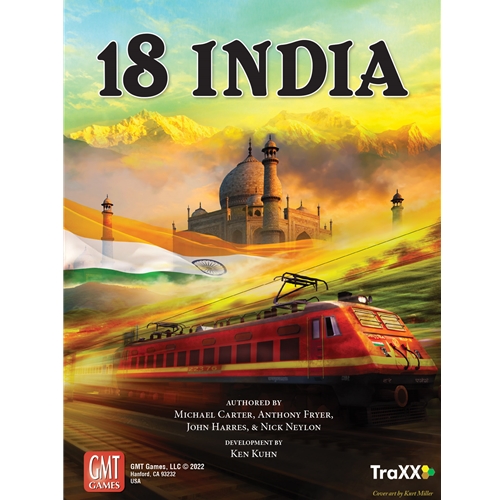India’s railroad history began in 1837 when The Red Hill Railway used the country’s first steam-powered locomotive to carry stone for road work to Madras, modern day Chennai. In 1845, India’s first railway was incorporated, the Madras Railway. Sixteen years later, on a warm April day in 1853, a 14-carriage train carrying 400 passengers was hauled 21 miles by three steam locomotives – the Sahib, Sindh, and Sultan – and passenger railway service was thus initiated in India. From there, as they say, the rest is history, and India today has the world’s fourth largest railway network.
18 India is an operational railroad game for 2 to 5 people that plays in about 3 hours. The game is inspired by 1829 Mainline by Francis Tresham, and while the venerable Mr. Tresham created some novel mechanics for that game, many of them are not ideal for players that eschew in-game randomness. In 18 India, those random elements are transformed into an amazing level of pre-game variability, which gives each session of the game a different character. Critically, 18 India causes players to think differently about 18XX standards such as train management and investments.
The mechanics in 18 India include: track gauge changes, “Guarantee Companies”, competition for commodity contracts, shares with exclusive rights to purchase, train trade-ins, a unique IPO display, and all track upgrades being available from the beginning of the game. By the way, trains do not rust, but there is certainly still a “train rush”!
– Playtester Comment
At game’s end, each player’s net worth – the value of their stock portfolio, factoring in the book value of the companies, and their cash – is their final score. The player with the most wealth wins.

GAME PLAY
18 India is easy to learn for those new to 18XX, but rich and complex enough to challenge experienced players.
What do you mean trains don’t rust?
In most 18XX games, older trains become obsolete – or “rust”, and leave the game – as newer and better trains become available. In 18 India , trains do not rust. Instead, older trains may be traded in on newer and better trains. Additionally, companies can purchase these used, traded in models, and continue to operate them. Of course, if your railroad companies are not competitive in purchasing the better trains, they will be out-earned and you will have a difficult time winning the game. It is a different type of train rush. Instead of trying to avoid getting caught without a train, companies must find a way to get one of the best trains as quickly as possible.
Commodity Contracts
Railroads can earn extra revenue by delivering commodity goods from the interior of India to its port cities. In 18 India , there is fierce competition to be the first to complete these commodity routes!
Guarantee Companies
To encourage railroad investment and construction, the British Parliament actually guaranteed some of its railways to help entice investors and to incentivize construction. We incorporated this historical tidbit into 18 India by having three Guarantee Companies in play in every game. As an investor, you are guaranteed a 5% dividend payment – even if the railroad does not make any money. What could be better than that?
Exclusive Stock Options
At the beginning of a game of 18 India , players will draft a hand of share certificates. These certificates are stock options that the player may choose to invest in during play. In addition to buying certificates from the IPO and from the Bank Pool during Stock Rounds, players may also choose to purchase the certificates they hold in their hand. Until purchased, the certificates held in your hand are not in play. When purchased, the cost of the share is paid to the corresponding company’s treasury – providing it with operating capital. Of course, there are sometimes reasons to not make all of the possible investments you initially drafted.
Unique Initial Public Offering (IPO) Display
One unique aspect of 18 India is how timing of play is affected by IPO share manipulation. During game setup, three rows of shuffled share certificates are placed in the IPO. During a Stock Round, players may use their turn to purchase up to two consecutive shares from any one row. During Operating Rounds, railroad companies may purchase one share from any row.
For a player to be successful, they must draft a coherent and flexible hand of stock options; stand up their first company(ies) quickly and with sufficient capital; then balance dividend payouts (necessary for acquiring more shares in the Stock Rounds) with strategic withholdings (necessary to climb the train roster and maximize route yields). Starting additional “second wave” companies can provide additional flexibility and support for a player’s “premier” company(ies), or be used as a harrying force to complicate other player’s route networks.
18 India has been extensively play-tested, iterated, and refined using feedback from a wide variety of players including some first-time 18XX players, and many long-time veterans. The finely-tuned and unique combination of pre-game variability, stock speculation, commodities, train roster, and intriguing mechanics creates a fresh and engaging game experience with every play.
COMPONENT LIST
-
1 22″ x 34″ Mounted Map
-
210 Track Tiles
-
125 Wooden Tokens
-
253 Cards
-
20 Company Charters
-
1 20-page Rulebook


Comentarios